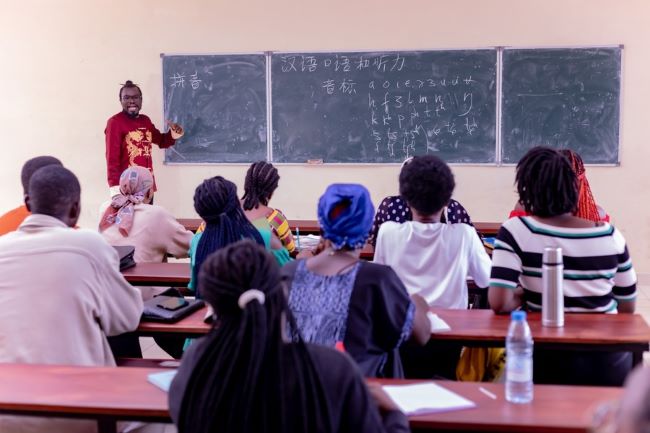Categories
Recent Posts
- Understanding the Biya Francophone regime’s support for the Israeli genocide in Gaza
- US: Prosecution lays out ‘criminal conspiracy’ as Trump’s hush money trial opens
- FAO formally launches Green Cities Initiative in Cameroon
- Football: Barcelona wants Clasico replay if Yamal ‘ghost goal’ call wrong
- Poverty under Biya: Cameroonians embrace Chinese language for brighter futures
Archives
- April 2024
- March 2024
- February 2024
- January 2024
- December 2023
- November 2023
- October 2023
- September 2023
- August 2023
- July 2023
- June 2023
- May 2023
- April 2023
- March 2023
- February 2023
- January 2023
- December 2022
- November 2022
- October 2022
- September 2022
- August 2022
- July 2022
- June 2022
- May 2022
- April 2022
- March 2022
- February 2022
- January 2022
- December 2021
- November 2021
- October 2021
- September 2021
- August 2021
- July 2021
- June 2021
- May 2021
- April 2021
- March 2021
- February 2021
- January 2021
- December 2020
- November 2020
- October 2020
- September 2020
- August 2020
- July 2020
- June 2020
- May 2020
- April 2020
- March 2020
- February 2020
- January 2020
- December 2019
- November 2019
- October 2019
- September 2019
- August 2019
- July 2019
- June 2019
- May 2019
- April 2019
- March 2019
- February 2019
- January 2019
- December 2018
- November 2018
- October 2018
- September 2018
- August 2018
- July 2018
- June 2018
- May 2018
- April 2018
- March 2018
- February 2018
- January 2018
- December 2017
- November 2017
- October 2017
- September 2017
- August 2017
- July 2017
- June 2017
- May 2017
- April 2017
- March 2017
- February 2017
- January 2017
- December 2016
- November 2016
- October 2016
- September 2016
- August 2016
- July 2016
- June 2016
Featured
 Understanding the Biya Francophone regime’s support for the Israeli genocide in Gaza
Understanding the Biya Francophone regime’s support for the Israeli genocide in Gaza  Poverty under Biya: Cameroonians embrace Chinese language for brighter futures
Poverty under Biya: Cameroonians embrace Chinese language for brighter futures  Cameroon is broken: Who can fix it?
Cameroon is broken: Who can fix it?  Ethiopia: U.S Senator Cardin Statement on the Killing of Bate Urgessa
Ethiopia: U.S Senator Cardin Statement on the Killing of Bate Urgessa  Battle for the Unity Palace: ANNOUNCEMENT!
Battle for the Unity Palace: ANNOUNCEMENT!
Most Commented Posts
 4 Anglophone detainees killed in Yaounde
4 Anglophone detainees killed in Yaounde
19 comments Chantal Biya says she will return to Cameroon if General Ivo Yenwo, Martin Belinga Eboutou and Ferdinand Ngoh Ngoh are sacked
Chantal Biya says she will return to Cameroon if General Ivo Yenwo, Martin Belinga Eboutou and Ferdinand Ngoh Ngoh are sacked
13 comments Anglophone Nationalism: Barrister Eyambe says “hidden plans are at work”
Anglophone Nationalism: Barrister Eyambe says “hidden plans are at work”
12 comments The Anglophone Problem – When Facts don’t Lie
The Anglophone Problem – When Facts don’t Lie
12 comments Largest wave of arrest by BIR in Bamenda
Largest wave of arrest by BIR in Bamenda
10 comments
Latest Tweets
Featured
-

Understanding the Biya Francophone regime’s support for the Israeli genocide in Gaza
-

US: Prosecution lays out ‘criminal conspiracy’ as Trump’s hush money trial opens
-

FAO formally launches Green Cities Initiative in Cameroon
-

Football: Barcelona wants Clasico replay if Yamal ‘ghost goal’ call wrong
-

Poverty under Biya: Cameroonians embrace Chinese language for brighter futures
-

US agrees to withdraw troops from key drone base in Niger
-

CPDM Crime Syndicate repays CFA39.8bn debt with new borrowings
© Cameroon Concord News 2024
16, October 2020
Cameroonian/Congolese US Asylum Seekers: Despite public outcry, many deported on a flight 0
Despite a public outcry and and letters from members of Congress calling for it to be stopped, a deportation flight took off on Tuesday afternoon, carrying asylum seekers from Cameroon and the Democratic Republic of Congo back to the countries from which they had fled.
Detainees, through their attorneys and other advocates, had raised concerns that they were going to be deported and that they believed they would be killed by their governments after they arrived. Members of Congress, including Rep. Bennie Thompson and Rep. Karen Bass, sent letters to Immigration and Customs Enforcement, asking the agency to stop the deportations. They cited a complaint made by eight men to the Department of Homeland Security Office of Civil Rights and Civil Liberties that said they had been forcibly coerced into signing paperwork related to their deportation.
“We urge you to halt the removal of Cameroonians until a fair, thorough, and transparent investigation into the allegations outlined in this very troubling complaint is complete,” Thompson and Bass wrote.
Protesters demonstrated outside the detention center in Texas where the asylum seekers were being held and filmed the buses that took the detainees to the airport.
But that didn’t stop the flight.
The plane left at close to 5 p.m. central time on Tuesday, according to Tom Cartwright, a volunteer with Witness at the Border, an organization that tracks Immigration and Customs Enforcement flights. It stopped in Senegal and then Cameroon before going on to the Democratic Republic of Congo and Kenya, he said.
Not all of the more than 200 Cameroonians and Congolese that detainees said were transferred to a detention facility in Texas to be deported were on the flight. Some of the group remained at Prairieland Detention Center, according to Rebekah Entralgo of Freedom For Immigrants, and a few were pulled from the flight due to individual legal actions taken on their behalf.
It remains unclear exactly how many people were deported on the flight. News articles in Cameroon reported varying numbers of deportees — 57 and 81.
ICE told the Union-Tribune on Monday that the agency could not give information about operations, including deportations that are not yet completed. ICE did not respond to a second request for comment about the deportation flight after it landed.
According to advocates, among those taken off of the flight were two men who were part of the eight who filed the complaint. One of them said his fingers had been broken, and the other said he’d been pepper-sprayed in the eyes. Another man who was part of the eight is also still in ICE custody, advocates said, but the other five are believed to have been deported.
A woman was taken off of the flight because she was identified as a class member in an ongoing lawsuit challenging the practice of limiting how many asylum seekers are processed at ports of entry on a given day, known as metering, as well as its intersection with a Trump administration change to asylum rules known as the third country transit ban. Asylum seekers who were metered before a certain date are not supposed to have the ban applied in their cases, according to the current ruling in the case.
The woman had not passed her screening interview because of the ban, according to court documents, but because of the court ruling she should be given another opportunity to make her case.
Attorneys are concerned that more asylum seekers who were affected by these policies may have been deported on the flight.
Another man was taken off of the flight because a group of Canadian activists convinced officials there to interview him for potential asylum in their country, according to reports from Canadian news outlets.
The client of local attorney Ruth Hargrove was also removed from the flight. She had filed a motion to stay his deportation while the Board of Immigration Appeals decides whether to reopen his case.
After the flight left, Hargrove said, her client’s deportation officer told her that it had been a mistake to take her client off of the flight and that he would soon be deported. ICE didn’t respond to a request for comment on her client’s situation.
According to Hargrove, her client, like many on the flight whose stories are known by attorneys and advocates, was a victim of torture at the hands of his government. She’s still fighting to find a way to protect him, either in the United States or Canada.
“I can’t ever say to him, ‘I’m giving up.’ I say to him that my mantra is what he said to me,” Hargrove said, recounting her client’s daring escape from prison in Cameroon. “What he told me was, ‘I preferred to die getting shot in the back as I ran for my freedom than being forced to kneel and being shot in the back of the head. I prefer to die standing up.’ I said to him, ‘I will keep giving you a voice until I am dead.’”
Advocates are still working to determine what had happened to deportees after they touched down. In Cameroon, they were tested for COVID-19, and those who tested positive were taken to a building near the airport and quarantined for 14 days, according to multiple accounts.
Pat Leach, a volunteer with Freedom For Immigrants who, since January, has become the pen pal of 45 people in immigration custody, said that six people she’d been communicating with were on the flight.
Leach coordinated with Cartwright to communicate with family members to have people ready to try to secure the release of the deportees once they landed.
The Congolese asylum seekers she knew managed to get released, despite a protest rally happening that day near the airport, she said.
Through bribes, family members were able to get a Cameroonian man released from government custody more than 12 hours after the plane landed, Leach said.
“What would have happened to them is they would go from the airport to jail, and jail is where everybody disappears or dies,” Leach said.
She’s still worried the military will go after her friends.
Source: The San Diego Union-Tribune